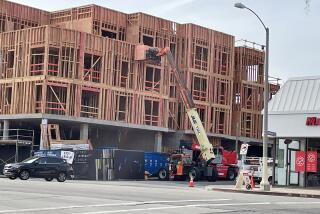School Districts Begin Levying Fees on New Homes, Development
- Share via
In a move that has angered the building industry, many California school districts are taking advantage of a new state law that allows them to impose fees on new houses and new commercial development.
Districts throughout the state, including the Los Angeles Unified School District, started moving in December to enact the fees, making them effective at the beginning of the new year, a spokesman for the California Building Industry Assn. said in Sacramento.
Buyers of new homes will find the fees passed on in the prices they pay. The fees also apply to habitable additions to existing homes. Non-habitable additions, such as garages, are not subject to the fees.
The new law allows districts to assess up to $1.50 a square foot on newly built or newly remodeled residences and up to 25 cents a square foot on commercial development.
The fee thus could be $4,500 for a 3,000-square-foot home, and $450 for a 300-square-foot addition.
Money from the fees can be used by districts for new schools or for renovating existing ones. Although the law does not limit districts that can impose the fees, some building industry officials claim that the intent of the legislation was to help districts facing major growth.
Instead, builders have complained, the fees are being imposed by almost all school districts, regardless of their need.
The law “is being abused because fees are being imposed by school districts that have stable or declining enrollment,” said John Erskine, executive director of the Orange County chapter of the California Building Industry Assn.
Not so, say school officials, who insist that the law was not intended just for growth areas.
“What some of the builders are forgetting is that many districts like ours have schools that are 25 to 30 years old and are in bad need of repair,” said Cheryl Norton, communications coordinator for the Fountain Valley School District. “The state for years has known that we need maintenance money, but when budget cuts have come down, maintenance money is the first thing that goes.”
What is clear so far is that the law is proving popular with educators. Although no tally is yet available on how many school districts in California have taken advantage of the law by imposing fees, “there’s a good likelihood” that virtually all school districts ultimately will adopt them, a lobbyist for the California School Boards Assn. said.
Under the new law, a school district for the first time can directly impose building fees. In the past, districts had to get permission from either a city council or a county board of supervisors.
The Legislature’s action in granting direct fee-assessing power to school districts was a “dramatic shift in authority,” the school board association noted in a recent newsletter.
“School districts who have been unable to convince their cities and counties to levy development fees are pleased that the legislation gives them direct authority to levy these fees,” the newsletter added.
Erskine, of the Orange County builders group, said that he and various city officials tried--unsuccessfully--to talk several school boards out of imposing the building fees.
“And where the school boards have acted, they’ve usually voted the entire amount,” Erskine said. “The $1.50 per square foot on residential construction was supposed to be the ceiling, but you know how these things work--the ceiling becomes the floor.”
Law Is Vague
In communities that have separate elementary and high school districts, the law is vague about whether the overlapping districts can each impose the maximum fee on residential and commercial development. The California School Boards Assn.’s recent newsletter said: “It is not clear . . . that anything in the legislation restricts both school districts from levying the maximum fee.” But the association warned school districts that it would be wiser to seek a split of the fees because “the Legislature intended that the $1.50 and $.25 per square foot cap be split between elementary and high school districts.”
Developers, who promoted an early version of the bill but then weren’t happy with the outcome, already have launched a move to get the law modified.
Bills to lower the amount of fees that school districts can impose or to repeal the fee-imposing power altogether are being prepared by Sacramento critics of the law, said Karen Steentofte, senior legislative advocate for the California School Boards Assn. She said the association would “fight tooth and nail” to oppose such moves in the current legislative session.
“We already think the cap on the fees is too low as it is,” she said.
Despite the complaints elsewhere, the fees were adopted in Los Angeles County last month with no opposition.
Bill Rivera, a spokesman for the Los Angeles district, said that system--the largest in the state--passed the fees on Dec. 15 without protest from builders or any other group.
More to Read
Sign up for Essential California
The most important California stories and recommendations in your inbox every morning.
You may occasionally receive promotional content from the Los Angeles Times.










